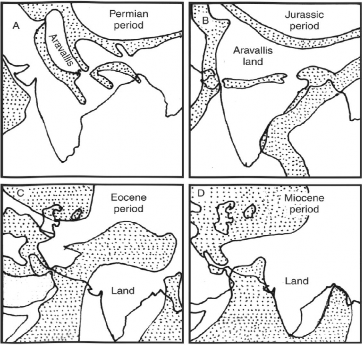THE TERTIARY SYSTEM (THE CENOZOIC ERA)
Cenozoic means recent life. The beginning of the Tertiary Period is about 6.5 million years ago. Fossils in these rocks include many types, closely related to modern forms, including mammals, plants and invertebrates. The Cenozoic Era has two periods: The Tertiary and the Quaternary.
The two great events that occurred during the Tertiary Period include: (i) the final beaking-up of the old Gondwana continent, and (ii) the uplift of the Tethys geosyncline in the form of the Himalayas. During the early Tertiary Period, as India collided with Tibet, the sediments which had been accumulatingin the Tethys basin had begun to rise by a slow rise of ocean bottom. The upheaval of the Himalayas altered the old topography of the subcontinent (Fig. 1.7).

Fig. 1.7 Change in Topography of Subcontinent
Three phases of the upheaval of the Himalayas have been distinguished:
(i) During the first upheaval (Eocene—about 65 million years ago), which culminated in the Oligocene, and resulted in the upheaval of the Greater Himalayas.
(ii) It was followed by a more intense movement during the mid-Miocene period about 45 million years ago, which resulted in the folding of Lesser Himalayas.
(iii) The third upheaval took place during the Post-Pliocene period, about 1.4 million years ago which resulted in the folding of Shiwaliks or the Outer Himalayas. There is enough evidence to prove that the Himalayas are still rising.
In the Peninsular region, the Tertiary System occurred on the coast of Kachchh, Kathiawar, Konkan, Malabar, Nilgiris, and the Eastern Ghats.
